Saying ‘Thank you’ in a formal setting is simple yet meaningful. It embodies one of the most powerful sentiments — gratitude.
But is there a fancier way of expressing our appreciation for someone?
How do we craft a professional ‘Thank you’ message at work?
We explore these questions and why it’s important to thank someone professionally.
Let’s begin!
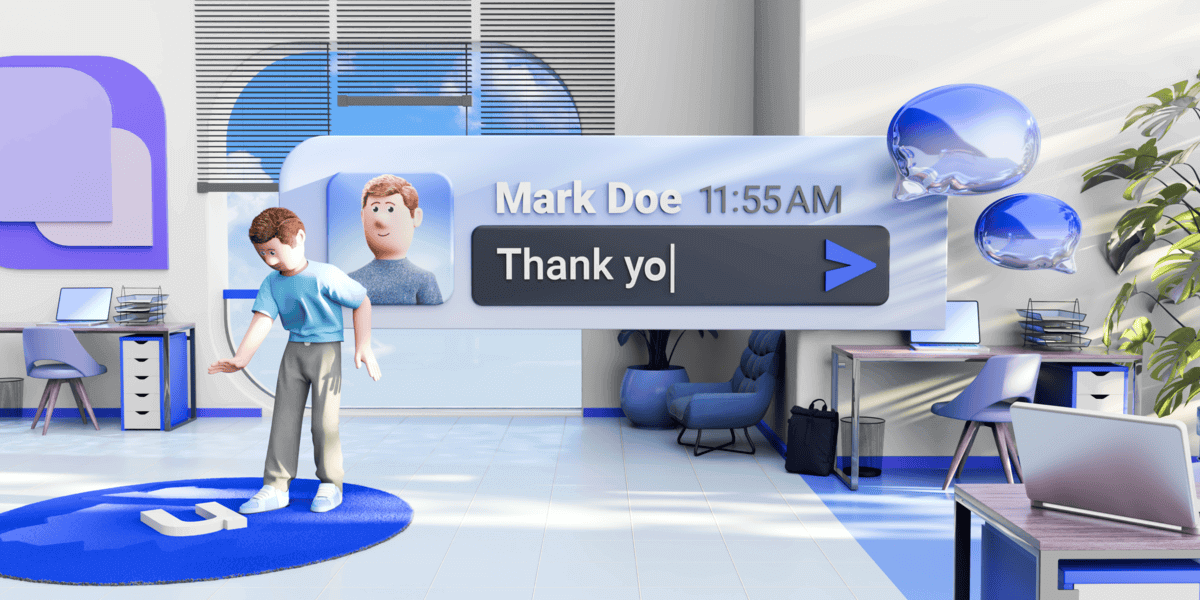
Table of Contents
How to write a professional ‘Thank you’ message in different situations
If you’re not sure how best to express your appreciation at work, don’t worry — we’ve got you covered.
Here, you can find thank-you phrases for various communication situations at work.
Professional “Thank you for your advice” phrases
We often take our colleagues’ or managers’ advice for granted, but taking a moment to acknowledge how it positively impacted our outcomes might mean the world to them.
Here are some phrases you can use to express your gratitude for a piece of advice:
“Thank you for your valuable advice.”
“Thank you for taking the time to speak with me.”
“I am grateful for your valuable insight.”
“I truly appreciate the advice you gave me.”
“Your advice has been most helpful — thank you!”
“I’m beyond grateful for the advice you gave me.”
“I appreciate the advice you have shared.”
“Thank you for sharing your thoughts with me.”
Here is an example that shows a professional thank you message for helpful advice.
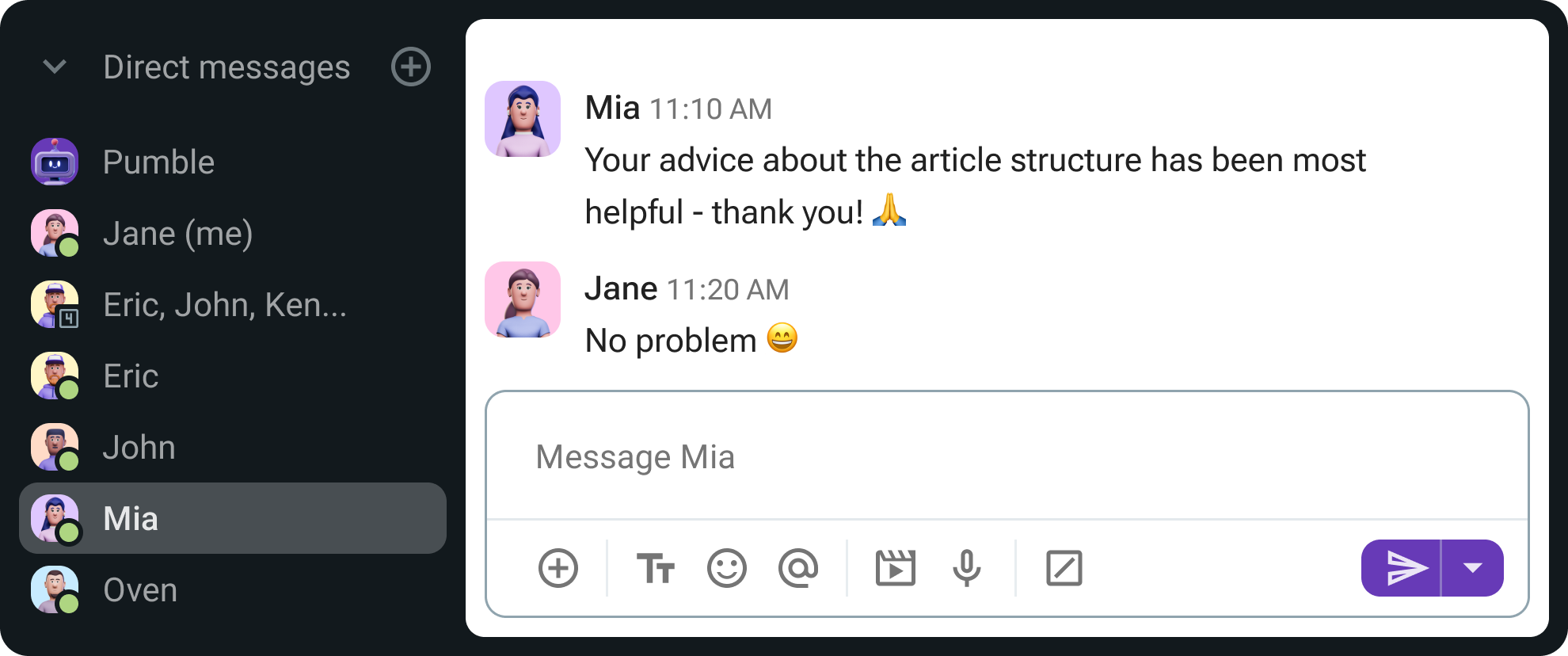
Use Pumble to give thanks to your team quick and easy
Professional “Thank you for your help/support” phrases
Thanking coworkers for their help or support builds a positive work environment and makes them more likely to help us again.
Here are some phrases you can use to thank the people you work with for their support:
“I’m deeply grateful for your unwavering support over the years.”
“I really appreciate your help.”
“I am grateful for your help and support today.”
“Your continued support means a lot to me!”
“I appreciate the way you supported me.”
“Your help is greatly appreciated.”
“I’m forever indebted to you for your support.”
“Thank you for all the help!”
Below is an illustration of one of our professional thank you message examples in Pumble, a team communication app.
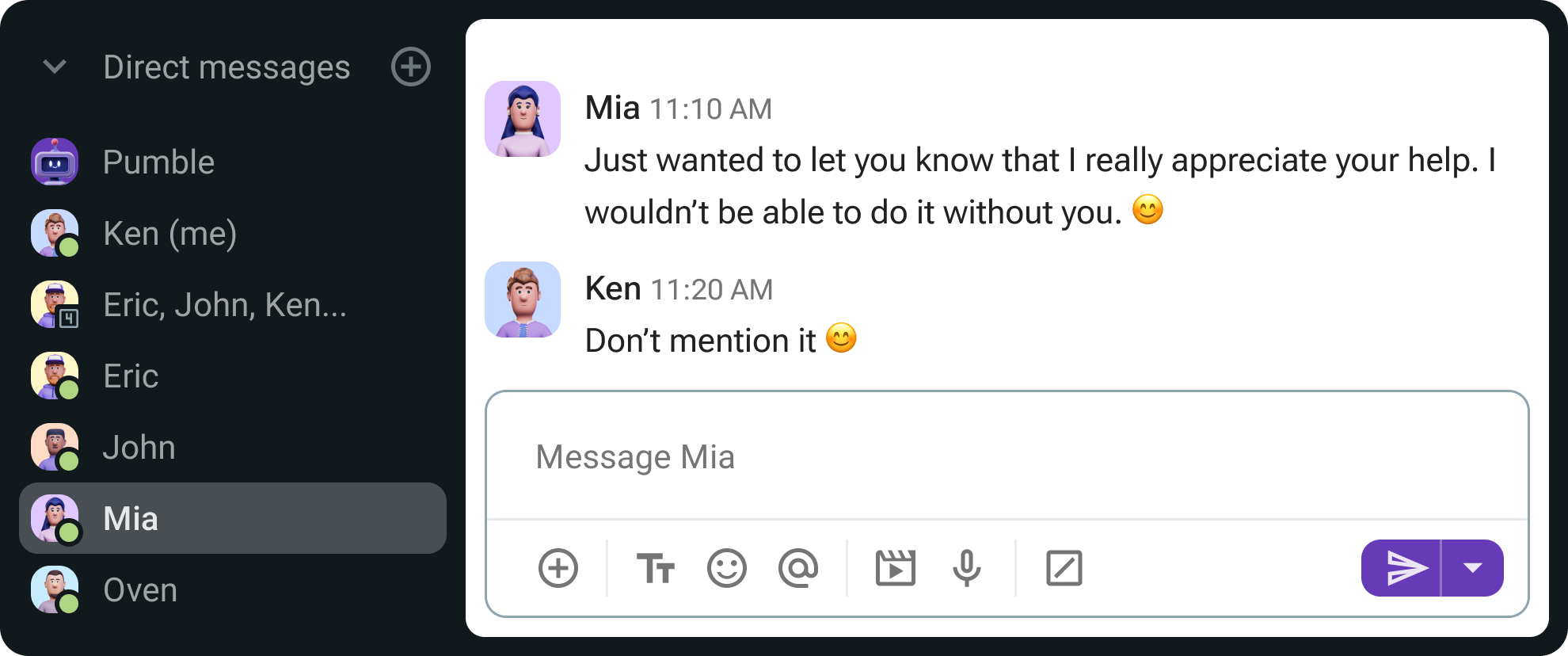
💡 PUMBLE PRO TIP
Asking for help at work might seem scary, but there is nothing to fear. It allows you to develop and learn and fosters a collaborative work environment. Learn how to do it properly through helpful examples in our article:
Professional “Thank you for your great work” phrases
As a manager, thanking your employees for a job well done takes little time and significantly impacts their performance and engagement.
Here are some phrases you can use in a professional thank you message to your reports acknowledging their great work:
“Thank you for a job well done.”
“You continue to exceed my expectations — thank you for the hard work and effort you put into everything.”
“My special thanks to you for doing a great job on the project.”
“I applaud you for your excellent work this week.”
“I have to give credit where it’s due — great work today!”
“I would like to extend my gratitude to you all for your excellent work.”
“Thank you for consistently delivering outstanding results!”
“Grateful for the consistent excellence you bring to our team.”
Below is an example of a manager praising their employee for their excellent work on Pumble, an internal communication software.
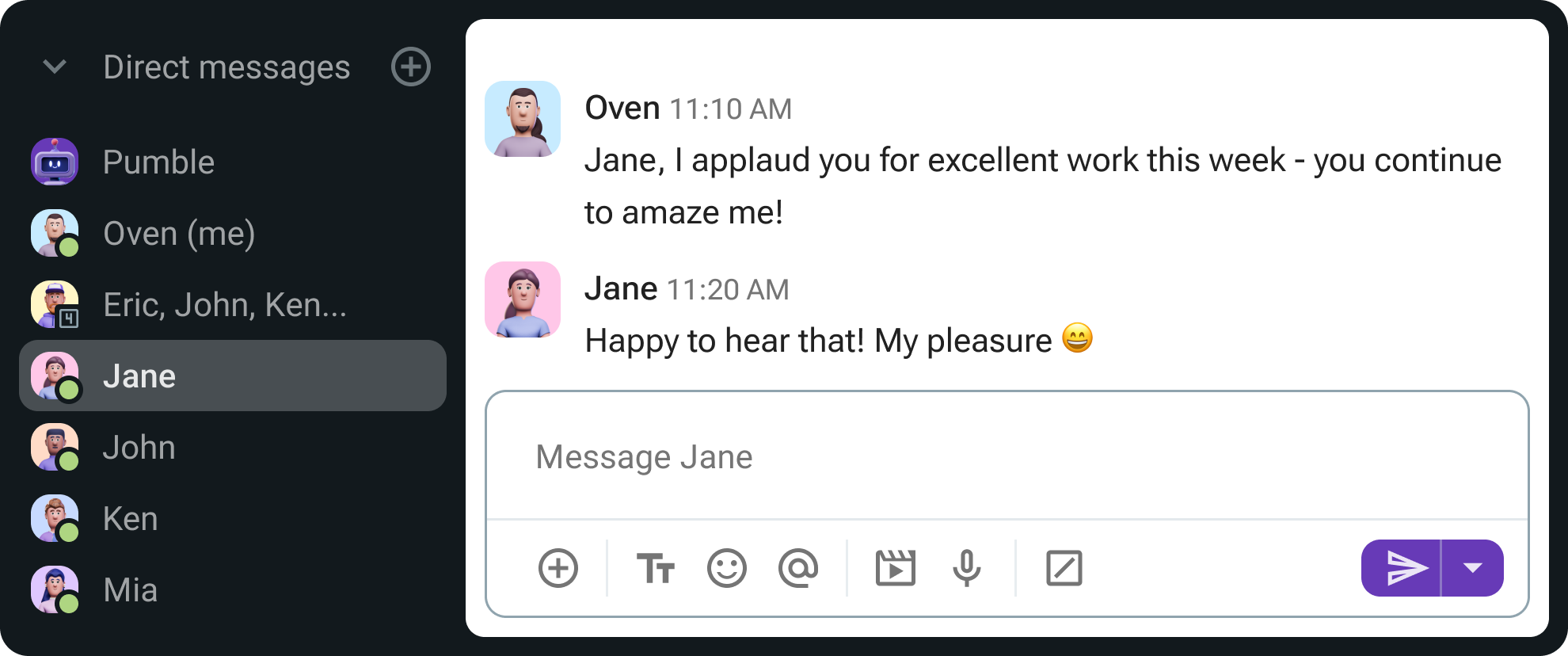
Use Pumble to acknowledge your teammates’ great work
💡 PUMBLE PRO TIP
Showcasing your appreciation for your employee’s good work is just one of the many qualities of a good manager. Learn more about how you can become an even better manager by reading our article on the topic:
Professional “Thank you for your consideration” phrases
Thanking someone for considering you for a job or a new role shows you value their time and effort and makes them more likely to choose you.
Here’s how you can thank someone for their consideration:
“Thank you for considering my request.”
“I appreciate your taking the time to consider my application.”
“My deepest thanks for your consideration.”
“Your consideration is greatly appreciated.”
“I am truly grateful for your consideration.”
“My thanks and appreciation for your consideration.”
“I appreciate your taking the time to consider my application.”
“I greatly appreciate your thoughtful consideration.”
Explore the screenshot below to see how you can write a professional thank you for your consideration message.
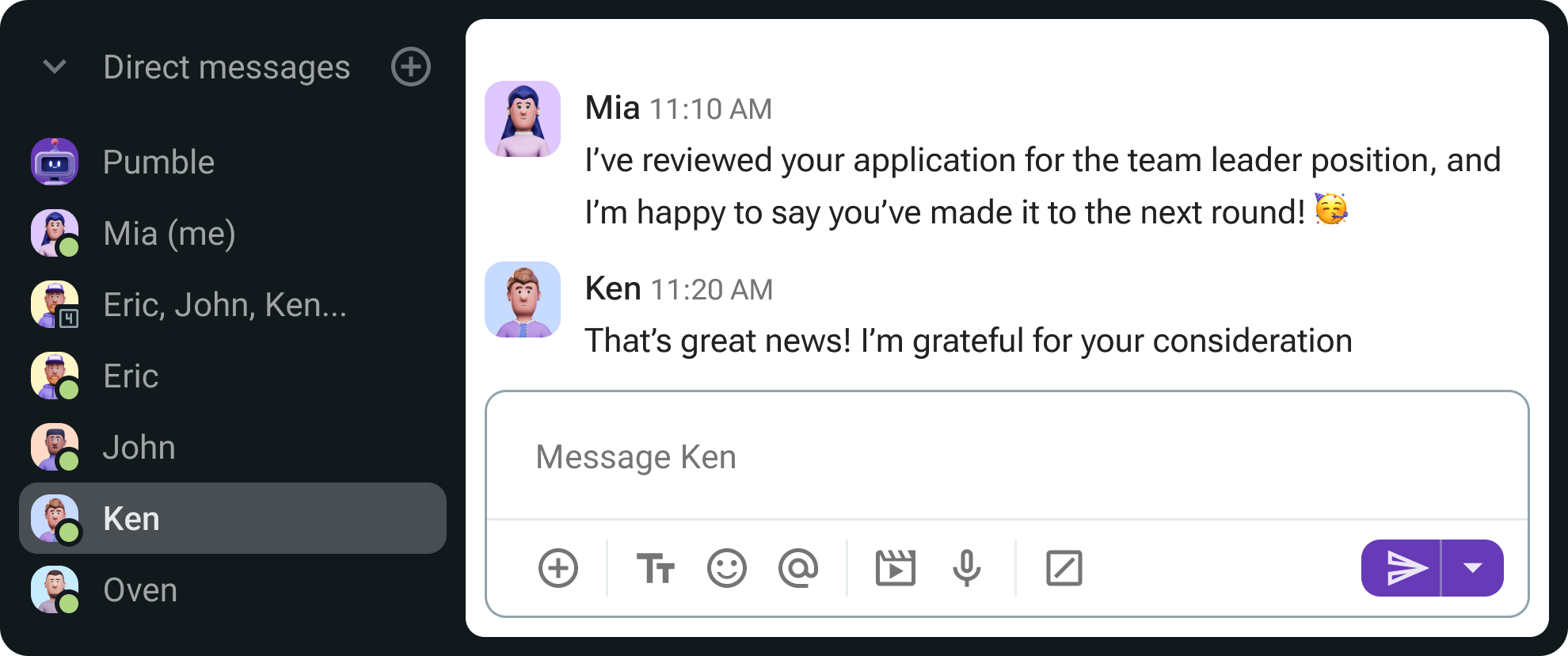
Professional “Thank you for this opportunity” phrases
Sometimes, a single opportunity someone has given us can open many doors and propel us into success. So, giving credit to those who opened the first door for you is essential.
Here are some phrases to thank someone for an opportunity they gave you:
“Thank you for the opportunity to be part of your team.”
“I cannot express how grateful I am for this opportunity.”
“Many thanks for giving me these opportunities to learn from the best team in the industry.”
“I am forever grateful for the opportunity to work on such an innovative project.”
“This opportunity has been a blessing for me — thank you from the bottom of my heart!”
“Thank you for giving me this opportunity to work with your company.”
“I cannot stress enough how much this opportunity means to me.”
“Heartfelt thanks for this invaluable opportunity!”
Here’s how an expression of an employee’s gratitude for a given opportunity might look like in practice.
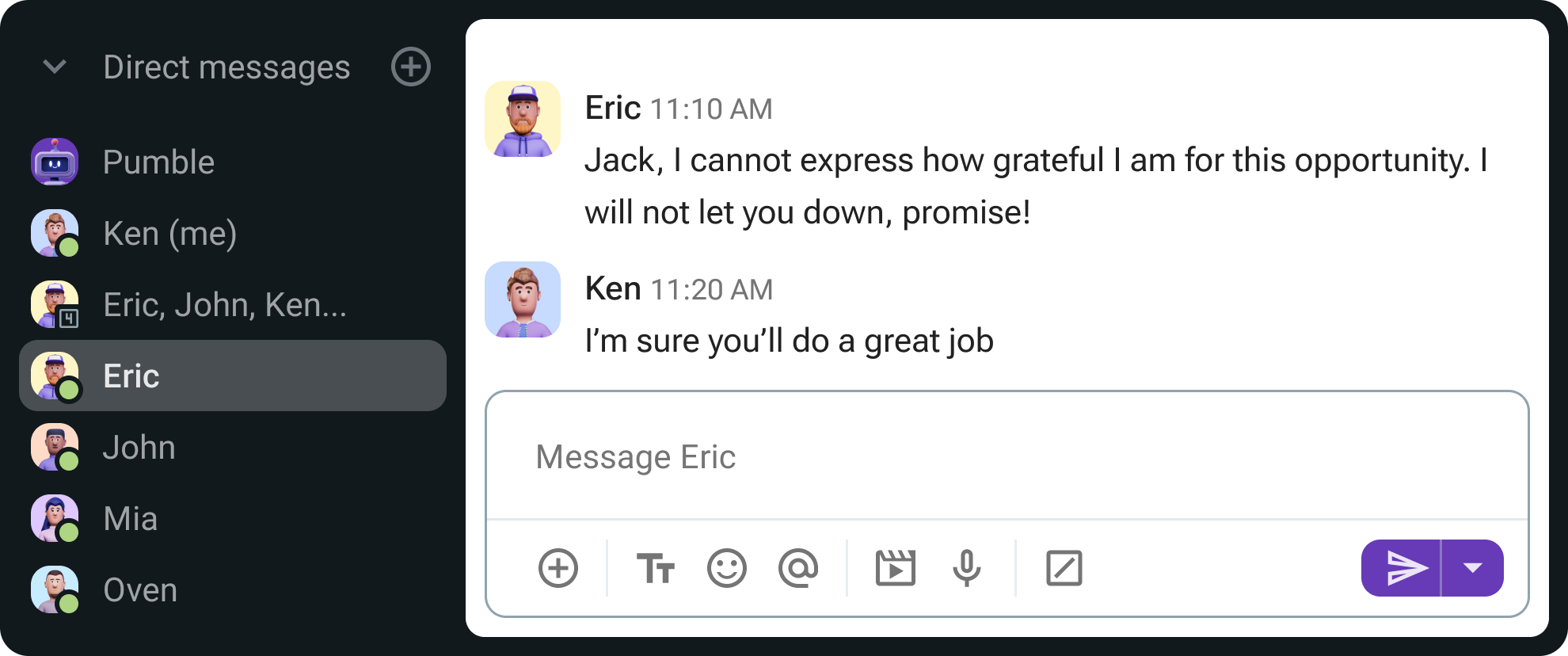
Professional “Thank you for your time” phrases
We’re all well aware of how precious time is, especially in today’s business world. Taking a moment to thank someone for the time they carved out for you is a must in business communication, as it shows the other person you’re a true professional and considerate of others.
Here’s how to professionally thank someone for their time:
“Thank you for taking the time to meet with me.”
“I greatly appreciate your time.”
“Thank you for carving out time for me in your busy schedule.”
“I appreciate you taking the time to help me do this.”
“Many thanks for your valuable time.”
“Your taking the time to do this means the world to me!”
“Grateful for our meeting – your time is truly appreciated.”
“Thank you for dedicating your time to assist me with this.”
Here’s another example to better understand how to thank coworkers for their time.
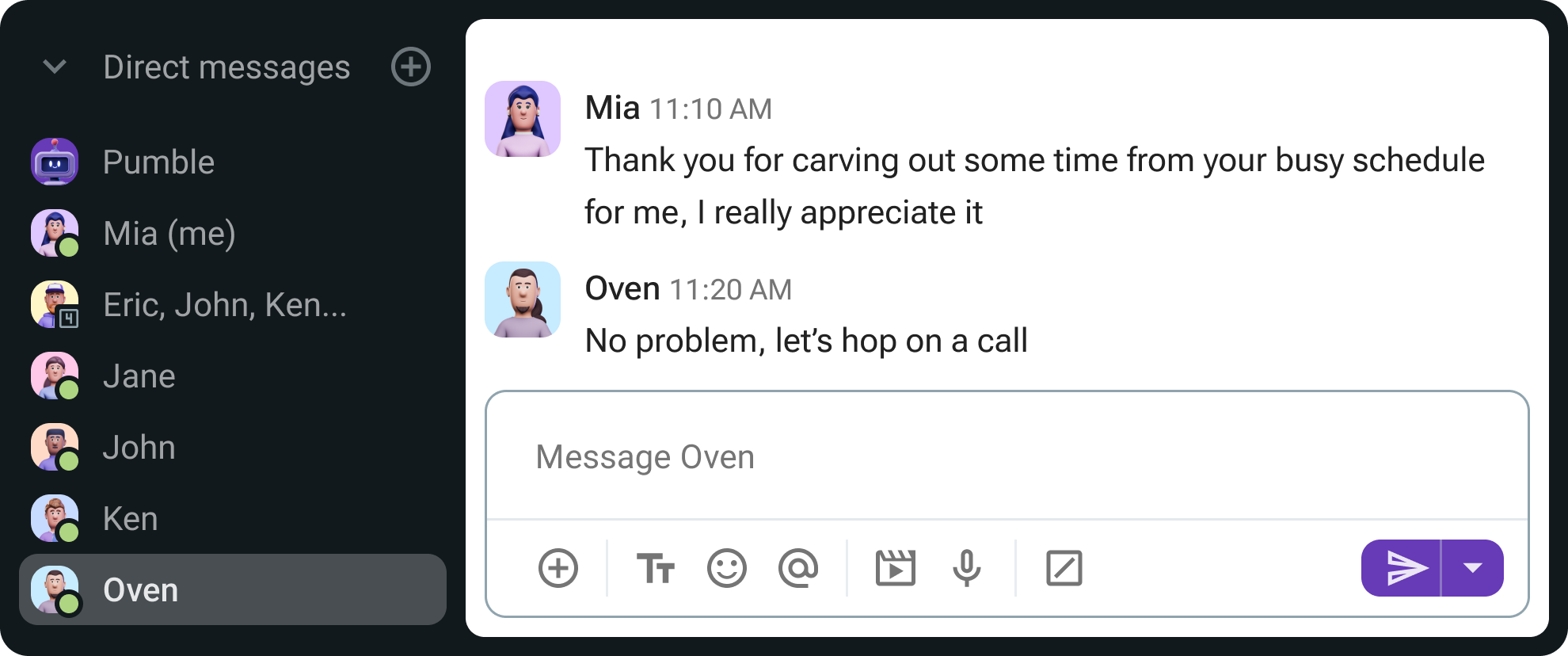
Professional “Thank you for connecting with me” phrases
The more extensive your professional network, the more opportunities open up.
Use one of these phrases to thank someone for connecting with you, whether on LinkedIn or elsewhere:
“Thank you so much for connecting with me. It’s an honor!”
“Thank you for adding me to your network — I look forward to learning more about your business!”
“Thanks for accepting my connection request.”
“I’m very pleased to have you in my network.”
“It’s a pleasure to connect with you on LinkedIn.”
“Many thanks for your connection request.”
“I sincerely appreciate being part of your network.”
“It means a lot to have access to a network of other professionals from my field.”
Below is an example of how a thank-you message for a new professional connection might look like.
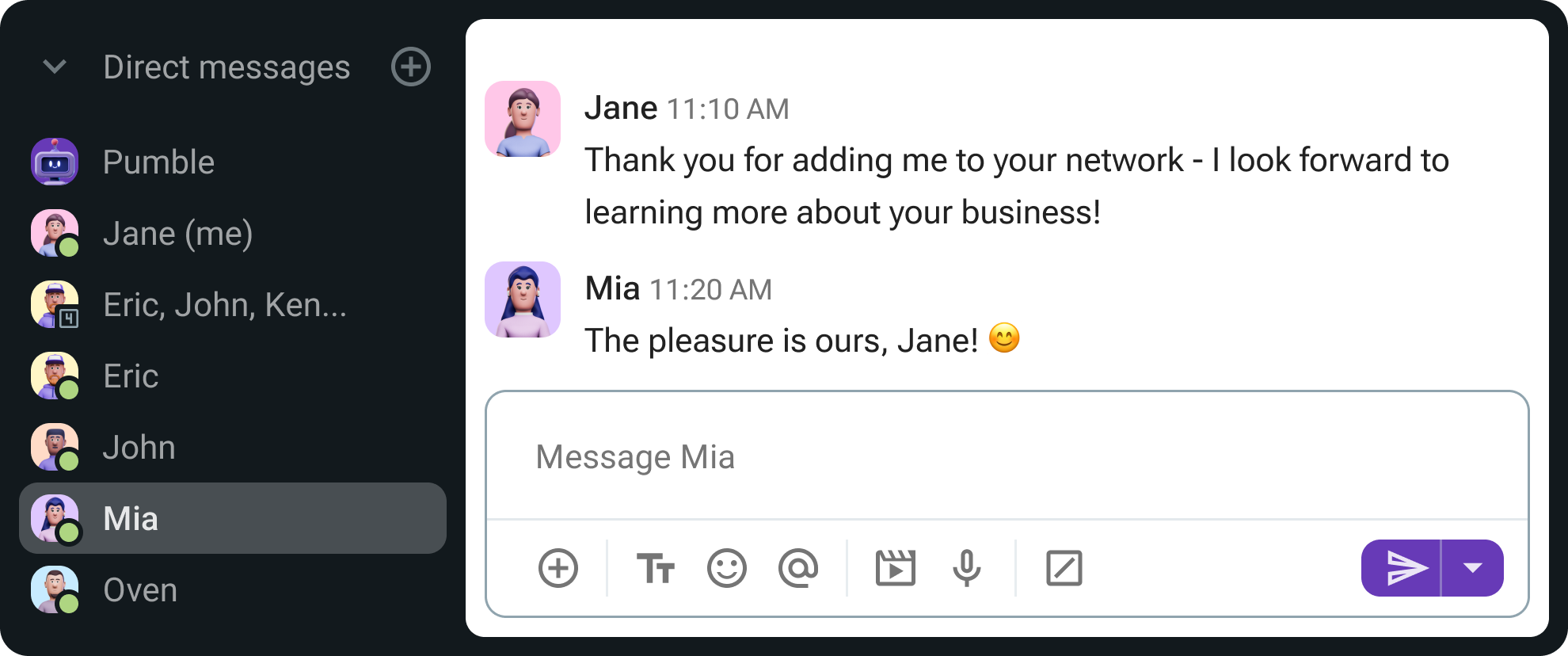
Build professional connections effortlessly over Pumble
💡 PUMBLE PRO TIP
Building a network of connections with people in and around your field can open many doors to new opportunities. Read our tips on how to become a pro networker and progress in your professional journey:
7 Tips on how to write a professional “Thank you” message
Saying “Thank you” professionally doesn’t mean you need to pull out a thesaurus to find a fancy way to phrase it. No need to be weird about it — the phrase “Thank you” is as good as any.
However, some practices help you express your appreciation at work without worrying about any of the what-ifs.
Tip #1: Check your motives
Gratitude works only if it’s genuine. The only valid reason for expressing it is actually feeling it.
Otherwise, it will sound inauthentic and phony.
Ensure your professional thank-you message is sincere, avoiding hidden or ulterior motives that may compromise authenticity.
Ask yourself: “Is there something I want to achieve with this thank-you note, or am I really being appreciative?”
You may be surprised by what you find out. After all, we all want to stand out at work, and you may be unintentionally kissing up to your boss.
Tip #2: Elaborate with context
Sometimes, our brains can interpret an unexpected compliment as a surprise attack and trigger a defense mode.
In practice, when we ambush a person with a compliment, especially in a business setting, they may instantly set their guard up and stop to think: “Wait a second, what does this person want from me?”
Prevent any misinterpretation by providing context before showing appreciation.
For example, if you want to thank a colleague for their help on a project, you can say something along the following lines:
“I was reflecting on my last project and how I almost missed the deadline, and I realized I couldn’t have done it without your help. So I just wanted to thank you — you saved me!”
💡 PUMBLE PRO TIP
Unfortunately, miscommunication at work is not a rare occurrence. If you want to know more about how to notice and avoid it, you can check out our blog post on the subject:
Tip #3: Choose the right medium
You can hardly go wrong when choosing the appropriate communication channel for expressing gratitude. As the saying goes — it’s the thought that counts.
However, you should consider a few things when deciding on the medium.
For instance, it might be better to send a well-crafted message so that the recipient can revisit the note whenever they need a little pick-me-up.
You can send:
- An email,
- A text message, or
- A DM in your employee communication app.
Of course, you also need to consider the nature of your relationship. A text message is much more appropriate for a colleague, whereas an email may be better for a client.
Consider a handwritten note as well, since it adds a personal touch.
If you want to be even more personal and direct about it, you can opt for a quick video or voice message.
Typed messages can sometimes miss conveying the exact tone and sentiment you intended to communicate. This is where voice messages can come in handy, letting you be more expressive and efficient.
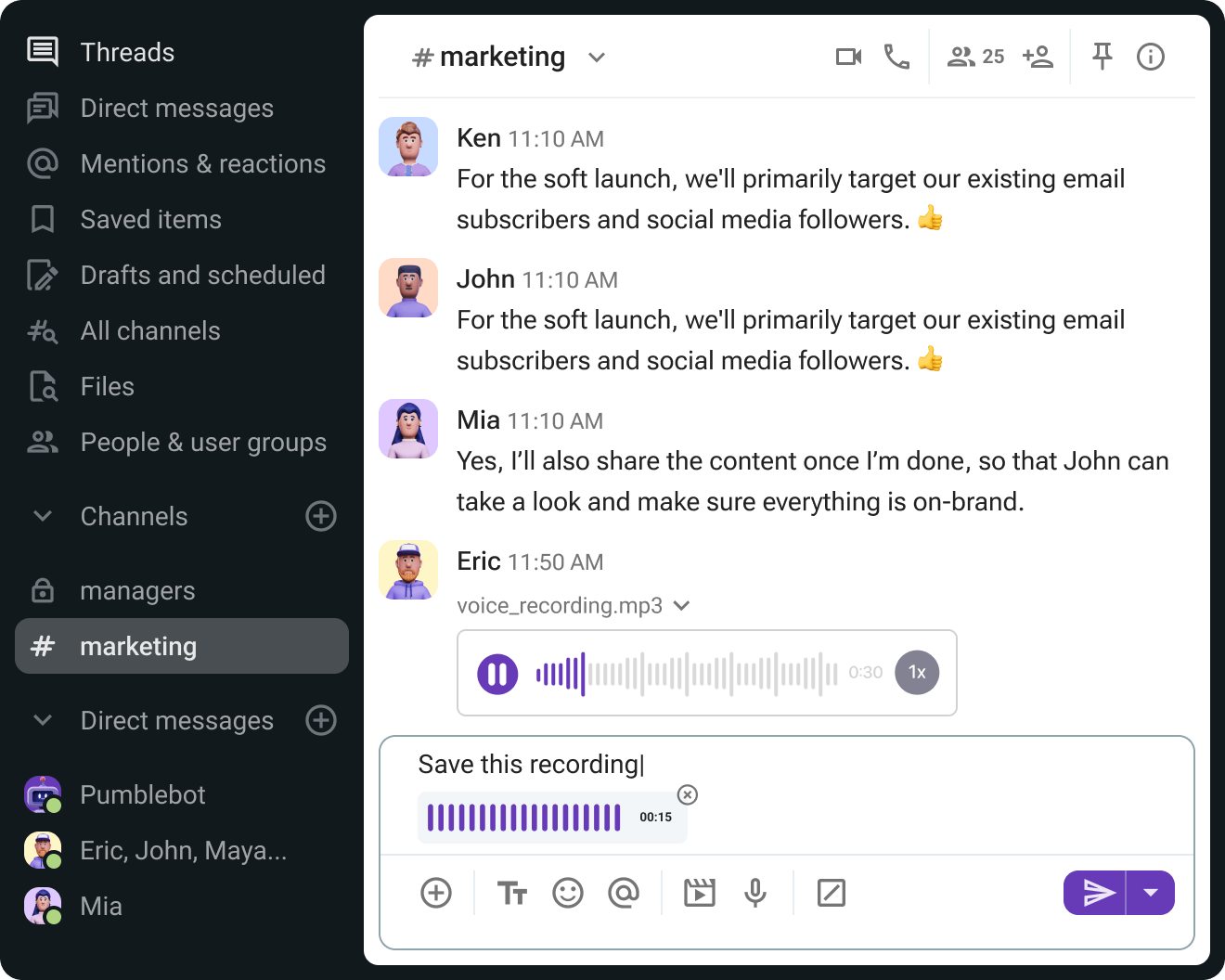
Whichever route you decide to take, remember to tailor your message to the nature of your relationship.
Pumble makes expressing gratitude to your coworkers easy
Tip #4: Don’t delay giving thanks
The best time to give thanks is always the present.
The longer you wait, the more awkward it will feel when you chime in with a “Thank you.”
Delayed thanks may raise questions about motives, so it’s best to acknowledge and appreciate your team members promptly.
Of course, this doesn’t mean you shouldn’t thank the person later if you only mustered the courage to do so. Follow our second tip, i.e., set the context before saying thank you professionally.
Tip #5: Consider the level of formality
Depending on your professional relationship with the receiver, consider the different levels of formality you can employ in your professional thank-you messages.
Let’s break it down roughly into 3 levels of formality:
- Casual,
- Semi-formal, and
- Formal.
Casual “Thank you”
Depending on how you communicate, you can be casual when giving thanks to coworkers and even managers.
Some phrases you can use include:
“You’re the best.”
“Thanks a million!”
“You rock!”
“Appreciate you big time!”
“You’re a lifesaver!”
Below is an example of a casual “Thank you” between close coworkers.
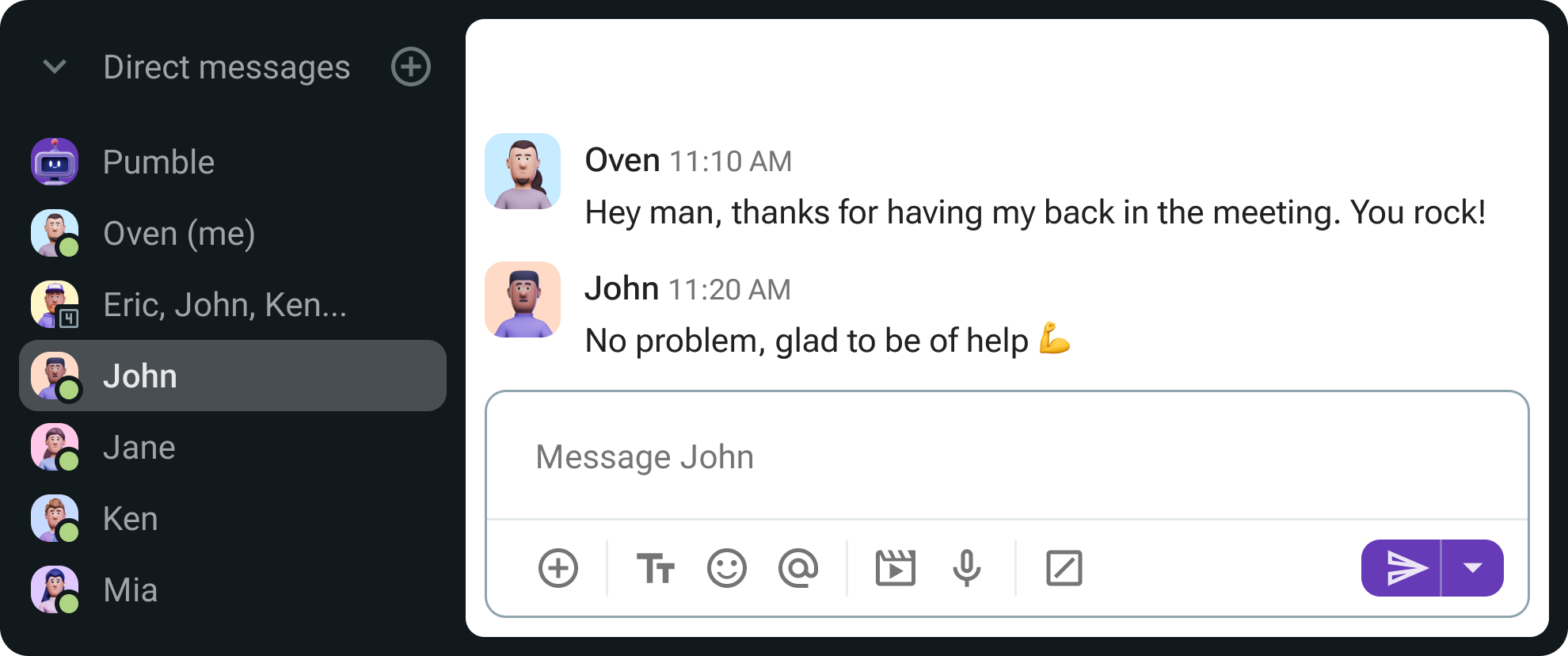
Semi-formal “Thank you”
You can use semi-formal expressions with your boss, people from other teams within your company you don’t know well, and anyone with whom you have a respectful but distant work relationship.
In many companies that embrace a more casual work culture, semi-formal is often “formal enough” for all occasions.
Some phrases you can use include:
“I truly appreciate…”
“I’m grateful for…”
“I just want to acknowledge…”
“Your help/assistance is truly valued…”
Here is another illustrated example, this time of a semi-formal thank you.
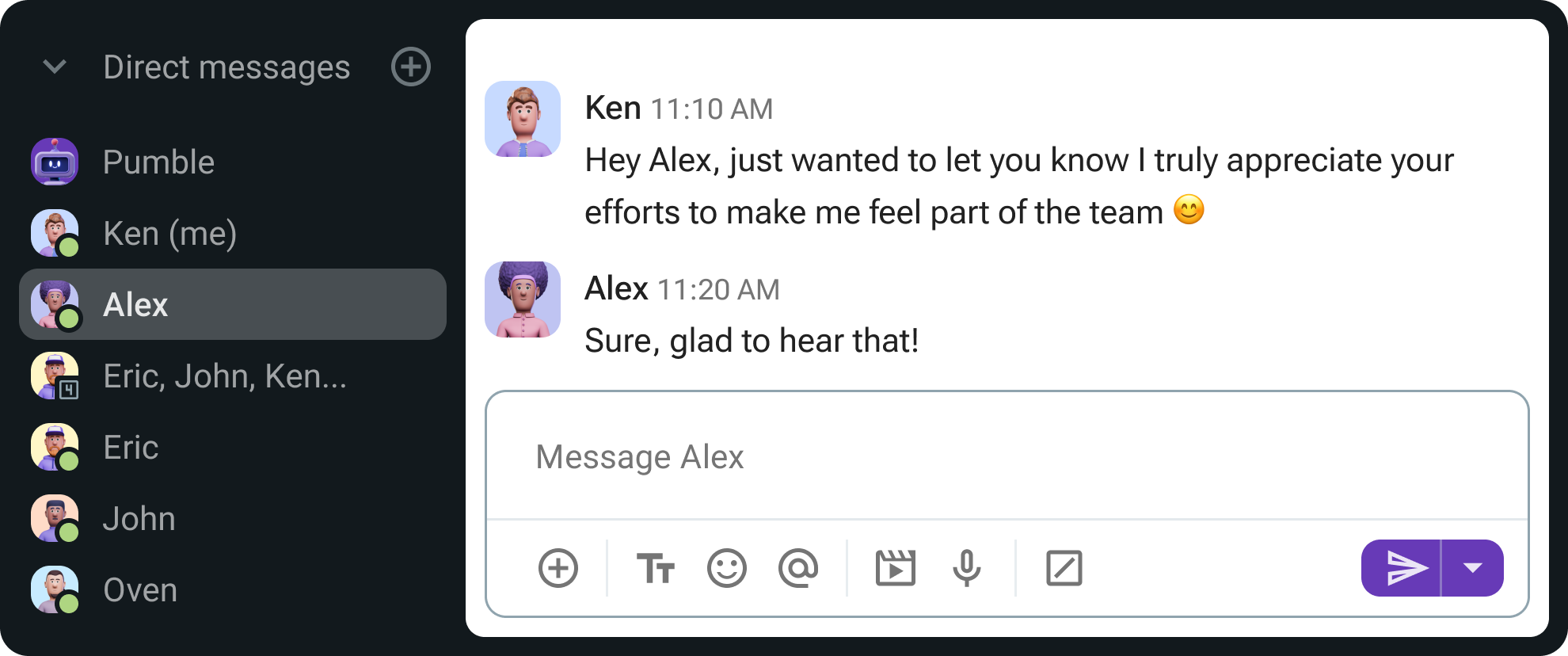
Formal “Thank you”
Depending on the nature of your job, you may need to take out your top hat and monocle when writing a professional thank-you message in your guest channels to:
- Clients,
- Business partners and higher-ups, or
- Other third parties.
Here are some phrases you can use:
“Please accept my deepest gratitude.”
“I stand in recognition…”
“I sincerely appreciate…”
“I extend my profound appreciation…”
“I wish to convey my utmost gratitude…”
Below is a formal “Thank you” towards a generous donor in Pumble, a business communication app.
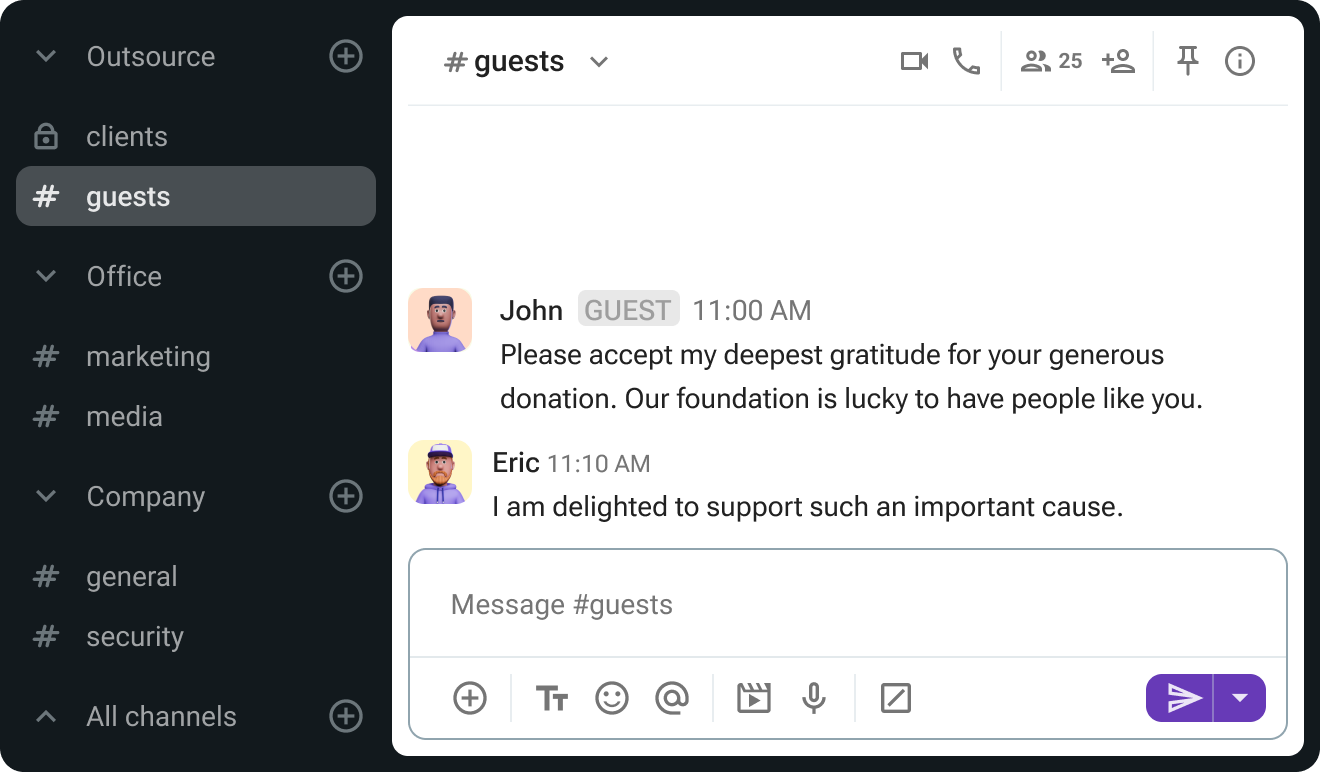
Tip #6: Personalize your message
This is significant if you send out many professional thank-you messages, e.g., to job interviewees.
Getting a generic thank-you note is worse than getting none whatsoever.
So, if you send them, try to personalize your professional thank-you messages to each recipient.
Highlight a specific detail or aspect about the individual or their contribution to show genuine appreciation.
For example, you can add something as simple as “We appreciate the enthusiasm you showed for the role by sending in your test assignment two days early.”
Tip #7: Keep it concise
It’s one thing to write an epic poem to your oldest friend about everything you want to thank them for and quite another to send a coworker a more formal thank-you message.
In gist — keep it to the point.
Avoid lengthy expressions of gratitude to make it easy for recipients to absorb and appreciate your message.
How do you write a professional thank-you email?
If you follow our top 7 tips, writing a formal thank-you email professionally will be a piece of cake — thank-you emails aren’t that different from thank-you messages.
You just need to:
- Include all the standard elements,
- Keep the message short and sweet, and
- Proofread before you send.
The standard elements of a professional thank-you email are the following:
- Subject line — It can be as simple as a “Thank you” followed by their name or a brief reason for expressing gratitude.
- Salutation — Tailor your greeting based on your relationship with the recipient. Choose from formal options like “Dear” or “Good morning,” or opt for a more casual “Hi” for close collaborators.
- Gratitude — This is where you give your thanks, followed by the specific reason for your appreciation.
- Connection reinforcement — Optionally, express your willingness to reciprocate or offer something in return, like taking them out for a coffee.
- Closing paragraph — In the closing part, you basically restate your gratitude to the person.
- Exit — Use any of the standard closing phrases, such as “Sincerely,” “Best regards,” or even “Appreciatively.”
When you get a hold of these elements, you can use them to formulate any type of thank-you email, whether you’re thanking a colleague for their support or a job interviewer for their time.
A professional thank-you email sample
Hi Mark,
Thank you for allowing me to work with you on the Daytona project.
It was a pleasure collaborating with your fantastic team. I learned so much from you and will apply that knowledge to my independent projects.
If there is anything I can do for you in the future, do not hesitate to reach out.
I am forever indebted to you for allowing me this experience.
With appreciation,
Rita Smith
You can get a professional thank-you email template here and tailor it to your specific needs:
⬇️ Professional thank-you email template
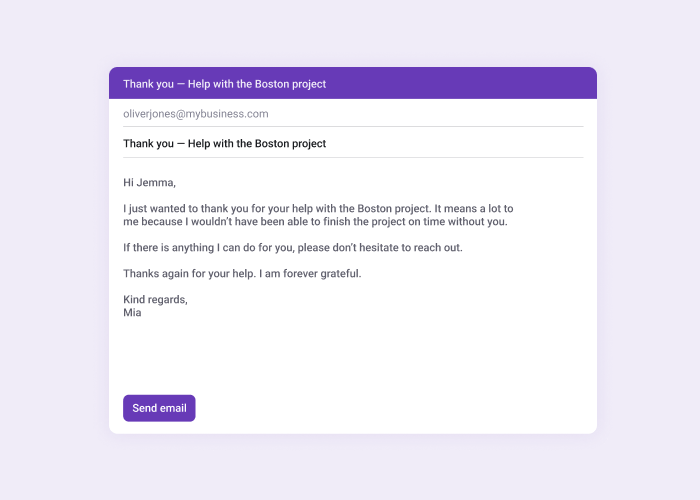
💡 PUMBLE PRO TIP
Pumble is a great alternative to email when expressing gratitude to your coworkers. There is no need for an elaborate structure; you can get straight to the point (as shown in all the screenshots above). Learn more about why email is probably not the best means of remote communication:
Why are people reluctant to say “Thank you” in a business setting?
Thanking colleagues, associates, clients, and others in our business environment can be daunting.
Why?
There are several reasons:
- Perceived competition — People often see work as a competitive arena, and some worry that sharing words of appreciation with their higher-ups can sound like kissing up or masking an ulterior motive.
- Fear of misinterpretation — Sometimes a simple acknowledgment can be misinterpreted as a romantic advance, so concerns arise about the potential misinterpretation of peer appreciation.
- Avoiding unintended impressions — Others don’t want to risk choosing the wrong words and sounding unprofessional or pathetic.
- Discomfort avoidance — Some professionals don’t want to make their colleagues uncomfortable. Studies show that a surprise compliment triggers the same pathways in our brains as a sneak attack (thanks, prehistoric ancestors).
However, the benefits of thanking people far outweigh our discomfort — we just need to be mindful about how we do it.
💡 PUMBLE PRO TIP
Understanding the most common communication models and how they play out in modern workplace communication can help you avoid discomfort and misunderstanding and plan successful communication situations. Learn all about it in our complete guide:
Why is it important to say “Thank you” at work?
Giving thanks is not just a nice gesture. Research suggests it can be so beneficial that it can improve your physical health and help you feel more positive in the long run.
So, it’s not only suitable for the recipient of your appreciation, it’s also great for you.
Everybody wins!
Let’s look at some compelling reasons to unabashedly give thanks at work.
#1: Saying thank you professionally boosts our well-being
Interestingly, in positive psychology research, gratitude has been strongly correlated with greater happiness and strong interpersonal relationships.
So, if work tends to wear you down, try saying ‘Thank you’ whenever you can — and see how it brightens the mood.
#2: Saying thank you professionally reduces work-related stress
Amid the ongoing burnout pandemic, giving thanks emerges as a simple yet effective tool to combat work-related stress and health problems.
Reflecting on the things you’re grateful for at the end of each workday decreases stress and improves overall health in the long run.
So, next time you feel stressed out at work, take a moment to focus on the good things and express appreciation by sending out some thank-you notes to your coworkers.
💡 PUMBLE PRO TIP
Read more about the importance of mental health in the workplace, its effects, and how to improve it:
#3: Saying thank you professionally improves job satisfaction
Some research suggests that organizations can improve overall job satisfaction among employees by institutionalizing gratitude into their work culture.
Managers, we’re looking at you. You can boost their morale and motivation by thanking your employees for a job well done.
Try Pumble for more effective communication
Likewise, a culture of mutual appreciation, where employees express thanks to one another, creates a positive and safe work environment.
#4: Saying thank you professionally drives better employee performance
Studies show that one of the defining traits of high-performing teams is showing and receiving appreciation.
Employees who feel valued almost unanimously report feeling more motivated and engaged at work, suggesting that employee recognition is a key driving force behind high performance.
💡 PUMBLE PRO TIP
Many other attributes characterize high-performing teams that, when improved, can boost productivity and outcomes in the workplace. Learn more about them in this guide:
#5: Saying thank you professionally instead of apologizing helps shift perspective
If you’re a chronic apologizer, we’ve got a pro tip for you — stop apologizing and start thanking people in your professional life instead.
Whatever your mistake is, thanking people for their patience and understanding can help change their mind and see you more positively.
For example, research indicates that saying “Thank you for your patience/understanding” is a much more effective recovery strategy than apologizing when dealing with dissatisfied clients.
By thanking clients, you spotlight their merit instead of your mistake and drastically shift their perspective.
You can try the same in internal communication with your colleagues.
For instance, if you are late to a meeting, instead of saying, “Sorry I’m late,” thank everyone for their patience and see what happens.
However, some situations, such as workplace conflict, require you to say you’re sorry — which doesn’t mean you can’t also thank the other person for accepting your apology.
Cultivating workplace appreciation with Pumble
Expressing gratitude is a courteous gesture and a powerful tool for building positive relationships in the professional world.
As you learn how to say thank you meaningfully in the workplace, consider using Pumble, a team communication app designed for seamless collaboration.
Pumble eliminates communication barriers, allowing you to express gratitude directly and efficiently using its many features including:
- DMs,
- Channel conversations,
- Group messaging, and
- Scheduled messages.
For a more immediate approach, you can record audio or video messages in Pumble and give your team a brief, personalized thank you.
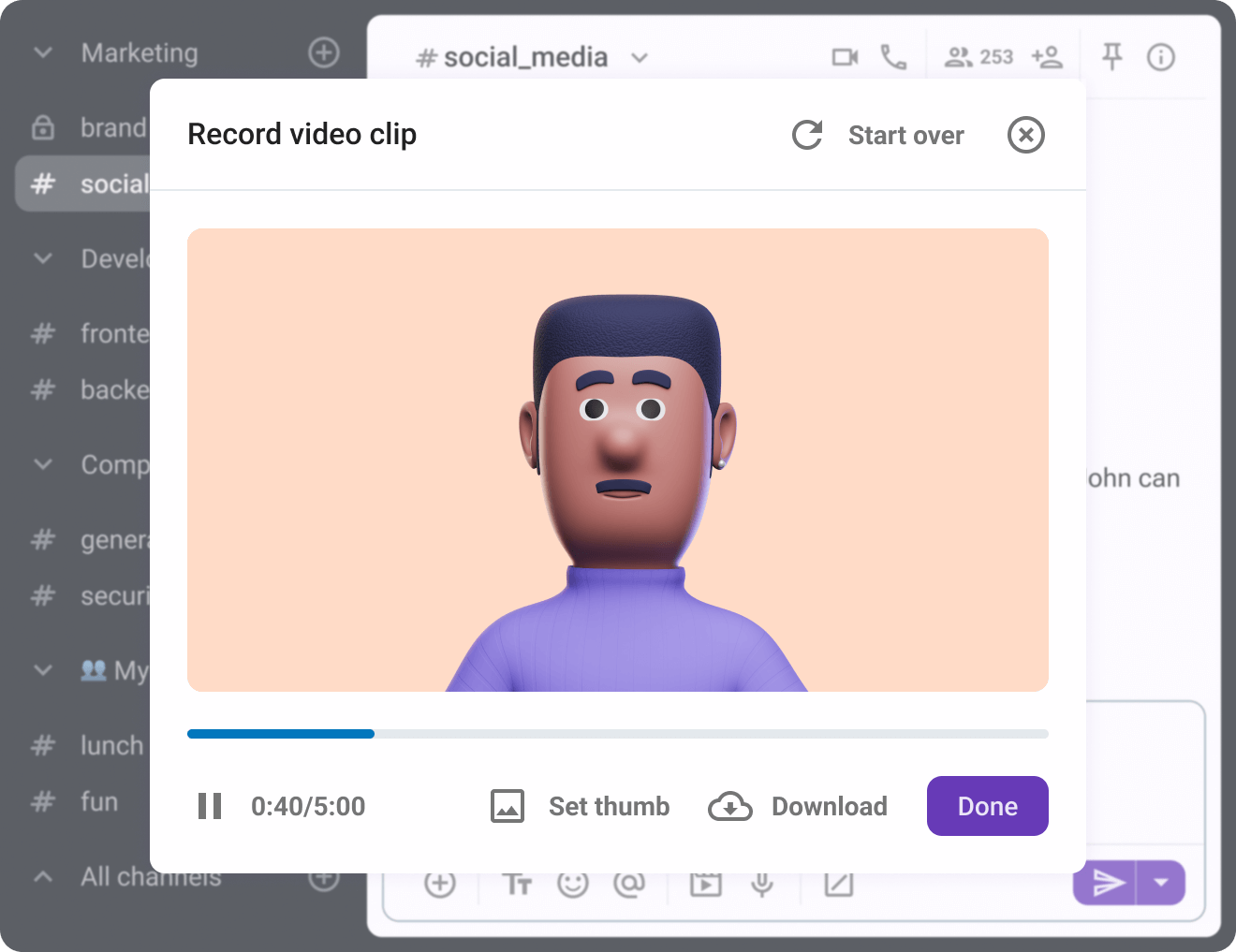
Keep the connection and appreciation in your team with Pumble.







